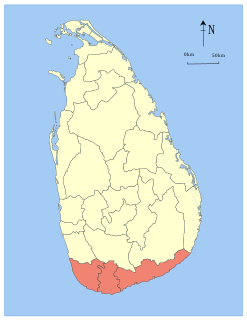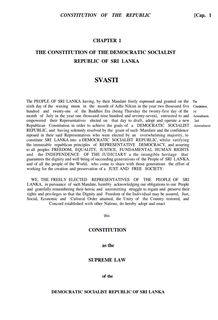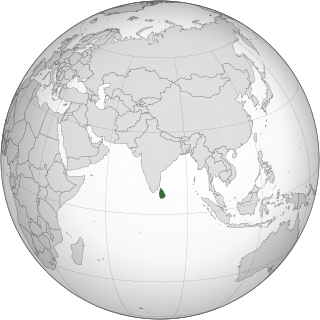Related Research Articles

Sri Lanka, formerly known as Ceylon and officially the Democratic Socialist Republic of Sri Lanka, is an island country in South Asia. It lies in the Indian Ocean, southwest of the Bay of Bengal, and southeast of the Arabian Sea; it is separated from the Indian subcontinent by the Gulf of Mannar and the Palk Strait. Sri Lanka shares a maritime border with India and the Maldives. Sri Jayawardenepura Kotte is its legislative capital, and Colombo is its largest city and financial centre.

The Government of Sri Lanka (GoSL) is a parliamentary system determined by the Sri Lankan Constitution. It administers the island from both its commercial capital of Colombo and the administrative capital of Sri Jayawardenepura Kotte.

The president of Sri Lanka is the head of state and chief executive of the Democratic Socialist Republic of Sri Lanka. The president is the chief executive of the union government and the commander-in-chief of the Sri Lanka Armed Forces.

The Parliament of the Democratic Socialist Republic of Sri Lanka is the supreme legislative body of Sri Lanka. It alone possesses legislative supremacy and thereby ultimate power over all other political bodies in the island. It is modelled after the British Parliament.

The Southern Province of Sri Lanka is one of the nine provinces of Sri Lanka, the first level administrative division of the country. The provinces have existed since the 19th century but did not have any legal status until 1987 when the 13th Amendment to the Constitution of Sri Lanka established provincial councils. It is the 7th largest province by area and is home to 2.5 million people, the 3rd most populated province. The province is bordered by Sabaragamuwa Province and Uva Province to the North, Eastern Province to the Northeast, Western Province to the Northwest and the Indian Ocean to the South, West and East. The Province's capital is Galle.
The Official Language Act , commonly referred to as the Sinhala Only Act, was an act passed in the Parliament of Ceylon in 1956. The act replaced English with Sinhala as the sole official language of Ceylon, with the exclusion of Tamil.

In Sri Lanka, districts are the second-level administrative divisions, and are included in a province. There are 25 districts organized into 9 provinces. Each district is administered under a district secretary, who is appointed by the central government. The main tasks of the district secretariat involve coordinating communications and activities of the central government and divisional secretariats. The district secretariat is also responsible for implementing and monitoring development projects at the district level and assisting lower-level subdivisions in their activities, as well as revenue collection and coordination of elections in the district. A district is divided into a number of Divisional Secretary's Divisions, which are in turn subdivided into 14,022 grama niladhari divisions. There are 331 DS divisions in the country.

The Constitution of the Democratic Socialist Republic of Sri Lanka has been the constitution of the island nation of Sri Lanka since its original promulgation by the National State Assembly on 7 September 1978. As of August 2020 it has been formally amended 20 times.

Parliamentary elections were held in Sri Lanka on 21 July 1977. The result was a landslide victory for the United National Party, which won 140 of the 168 seats in the National State Assembly.
In Sri Lanka, the Cabinet of Ministers is the council of ministers that form the central government of Sri Lanka. The body of senior ministers responsible and answerable to the Parliament of Sri Lanka. The President is a member of the cabinet and its head.

The Speaker of the Parliament of the Democratic Socialist Republic of Sri Lanka is the presiding officer of the chamber. The current Speaker of the Parliament is Mahinda Yapa Abeywardena, in office since 20 August 2020. The Speaker fulfills a number of important functions in relation to the operation of the House, which is based upon the British Westminster Parliamentary system.
The Chief Justice of the Democratic Socialist Republic of Sri Lanka is the head of the judiciary of Sri Lanka and the Supreme Court of Sri Lanka. Established in 1801, the Chief Justice is one of ten Supreme Court justices; the other nine are the Puisne Justices of the Supreme Court of Sri Lanka. The post was created in 1801. The Chief Justice is nominated by the Constitutional Council, and appointed by the President. The first Chief Justice was Codrington Edmund Carrington. The 47th and current Chief Justice is Jayantha Jayasuriya.

The Attorney General of Sri Lanka is the Sri Lankan government's chief legal adviser, and its primary lawyer in the Supreme Court of Sri Lanka. The Attorney General is usually a highly respected Senior Advocate, and is appointed by the ruling government. The current Attorney General is Sanjay Rajaratnam. The president does not have any power to make orders, mandatory or otherwise, to the attorney general. He heads the Attorney General's Department which is the public prosecutor.
The 1978 Constitution of Sri Lanka provides for the election of members of Parliament from 22 multi-member electoral districts through the proportional representation electoral system.

Northern Provincial Council is the provincial council for the Northern Province in Sri Lanka. In accordance with the Sri Lankan constitution, NPC has legislative power over a variety of matters including agriculture, education, health, housing, local government, planning, road transport and social services. The constitution also gives it powers over police and land but successive central governments have refused to devolve these powers to the provinces. NPC has 38 members elected using the open list proportional representation system.

The Prime Minister of the Democratic Socialist Republic of Sri Lanka is the head of government of Sri Lanka, and the most senior member of parliament in the cabinet of ministers. It is the second-most powerful position in Sri Lanka's executive branch behind the president, who is the constitutional chief executive. The Cabinet is collectively held accountable to parliament for their policies and actions.
The Thirteenth Amendment to the Constitution of Sri Lanka (13A) is amendment to the Constitution of Sri Lanka, passed in 1987, which created Provincial Councils in Sri Lanka.

The national symbols of Sri Lanka are the national anthem, flag, emblem, flower, tree, bird, butterfly, gemstone and sport. They represent the country and its people within Sri Lanka and abroad as well as traditions, culture, history and geography. Several other symbols do not have official acknowledgment as national symbols but are considered national symbols at the local level.
The Government of the Northern Province refers to the provincial government of the Northern Province of Sri Lanka. Under the Sri Lankan constitution the nine provincial governments of the country have power over a variety of matters including agriculture, education, health, housing, local government, planning, road transport and social services. The constitution also gives them powers over police and land but successive central governments have refused to devolve these powers to the provinces. Legislative power rests with the Northern Provincial Council whilst executive power rests with the Governor and Board of Ministers.